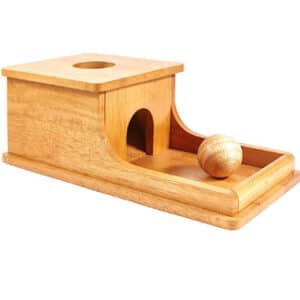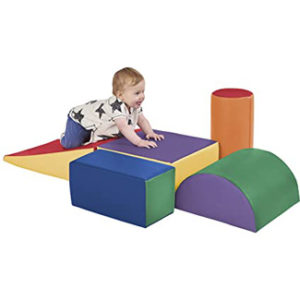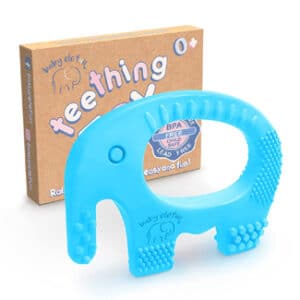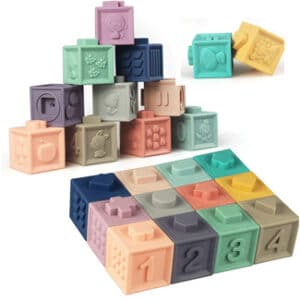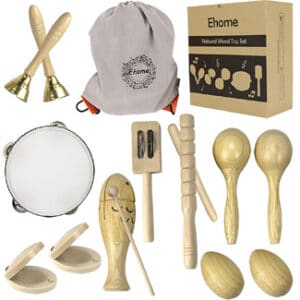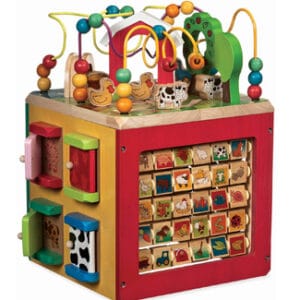As your little one gets older, you’ll begin to notice their skills developing at a rapid pace. From uttering their first words, to learning to crawl and balance on their own two feet, now is the best time to surround your child with toys and activities that support this period of growth. It’s never too early to begin introducing shapes and colors as well as setting up an environment that encourages them to experiment with how their body moves. These toys geared to 6 and 12 months old foster independent learning and allow them to explore and achieve new milestones.
7 Best Baby Toys – 6 to 12 Months (2025 Reviews)
Baby Toys for 6 to 12 Month Old Babies
-
1. Object Permanence Box
(Best for intellectual development — $$)
Why it’s great: Watching a ball disappear and reappear again is an excellent way to introduce the concept of object permanence to your little one. Their understanding that something still exists even when they cannot see it is an important developmental skill that can be achieved using an object permanence box. Made from eco-friendly wood with a ball large enough for little hands and mouths, you can rest assured that this activity was designed with 6-12 months old in mind.
Keep in mind: While this toy is great for introducing the concept of object permanence, don’t stop there. Encourage your child’s understanding by playing peekaboo or hiding objects under a blanket for your little one to find.
Good for: parents who want to help their baby reach important intellectual milestones.
![Montessori Object Permanence Box]()
-
2. Climb and Crawl Activity Set
(Best for gross-motor skills — $$$)
Why it’s great: Encourage your child’s balance and body awareness by setting up various obstacle courses using foam shapes. While crawling on the floor already has numerous benefits, adding in inclines and declines over varied cushions encourages babies to cross their center midlines, which is essential for hitting developmental milestones. The durable fabric is easy to wipe clean, and meets all the standards of Greenguard so you don’t have to worry about what your child is breathing in when playing.
Keep in mind: Although the material is soft, this activity requires parental supervision at all times to eliminate the risk of falling off the foam shapes. It is recommended to use on a soft surface, such as thick carpeting or soft grass.
Good for: providing baby with a safe setting to explore new skills
![Climb and Crawl Activity Set]()
-
3. Geometric Shapes Puzzle
(Best for introducing colors and shapes — $)
Why it’s great: A simple wooden puzzle ignites shape and color cognition in your baby’s brain. With three pieces available, consider offering your little one a single shape to match at a time before completing all three at once. To further engage your child, cut out pictures of their favorite animals or family members to place underneath each puzzle piece for a motivating surprise!
Keep in mind: Completing puzzles can be a difficult skill for some babies when first presented. Remember that completing the puzzle is not the only skill to be learned, but rather, use this as a valuable learning tool to introduce babies to various shapes and colors.
Good for: introducing shapes and color into baby’s receptive vocabulary.
![Geometric Shapes Puzzle]()
-
4. Teething Toy
(Best for teething babies — $)
Why it’s great: With various textures and an easy to hold grip, this is one of the best teethers out there. You can confidently offer the Baby Elefun on stroller walks or during playtime when their gums are sore as there are no loose parts or gels that could leak. The open handle allows them to grip it independently so you’re not picking up a pacifier off the floor every five minutes.
Keep in mind: Although teethers can help soothe a fussy baby, remember to never leave anything in the crib when your little one goes to sleep. Make sure this toy is used with supervision.
Good for: distracting teething babies while out and about.
![Baby Boy Teething Toys]()
-
5. Soft Stacking Blocks
(Best for open-ended play — $)
Why it’s great: Soft stacking blocks are a fantastic option for fostering independent learning and encouraging your child to experiment with open-ended play. Building a tower and watching the blocks fall introduces them to the concept of cause and effect. The soft silicone is nontoxic and not a concern should the blocks tumble on little toes or fingers. Plus, the animals, foods, letters, and shapes on each side are appealing for little minds.
Keep in mind: While the blocks can be wiped clean, be sure not to submerge them in water as the small air hole can trap moisture and cause mold growth.
Good for: offering baby a safe, open-ended toy to support creativity.
![Soft Stacking Blocks]()
On An Important Side Note… Asher and I (pictured) feel it’s necessary to highlight the value of life insurance for parents with young kids. After extensive research, we discovered that parents can get insured for as little as $10 per month. We use Ladder Life who offers coverage up to $3M per parent (without a medical exam, just a few health questions) and you can apply 100% online.
Get a quote in less than 30 seconds at LadderLife.com ➜
-
6. Wooden Musical Set
(Highest quality — $$)
Why it’s great: Although it may be a while until your baby is ready for their first piano lesson, this high quality musical set is sure to foster your baby’s understanding of sound and rhythm. These instruments are made for little hands to hold, so they’re easy to maneuver as you baby experiments with how different movements can cause different sounds, both in pitch and in volume.
Keep in mind: As with any toy, be sure to inspect that all pieces are fully intact and not cracked when offering it to your baby to ensure it’s safe and ready for play.
Good for: showing baby how to experiment with cause and effect by moving and shaking different instruments to hear different sounds.
![Ehome Toddler Musical Instruments]()
-
7. Wooden Activity Cube
(Best for independent play — $$$)
Why it’s great: With so much to do and see, this activity cube encourages your child to sit independently while focusing on the various tasks located on each side of the cube. The zig zag beads, drive-around tractor, and doors that open and close encourage your little one to problem solve as they navigate the numerous components available to them.
Keep in mind: This toy is targeted for babies closer to one year. Although the toy is sturdy on a flat surface, it can tip over if babies try to use it to support themselves when standing. Stay close to your little one and remind them to keep seated when playing with the activity cube.
Good for: parents who want to encourage independent play.
![Wooden Activity Cube]()
Object Permanence Box
FAQs about Baby Toys
-
1. What skills should I focus on for 6-12 month old babies when playing?
At this age, babies’ toys should help them work on sitting independently, transitioning into crawling, as well as pulling themselves up into standing. This is also an important time to introduce the concepts of cause and effect and object permanence with open-ended toys that foster independent experimentation. While it’s important to engage with your baby, especially when introducing new toys, don’t forget to sit back once in a while so your little one can experiment without a parent hovering and altering the direction of the task at hand.
-
2. What should I look for in toys for an older baby?
As teething becomes more prominent during this time, ensure all toys are safe for little mouths, both in the material used and in the size to avoid choking. As older babies become more mobile, keep in mind they’re more apt to take some spills and pull objects on to themselves, so make sure you play on a soft surface and supervise anything that could tip over. At this age, it’s also a good idea to find toys that can grow with them, rather than toys that have a very limited shelf life. Items that serve various purposes, such as foam shapes that can be used for tummy time for an infant and later as an obstacle course for a toddler, are excellent pieces to invest in.
-
3. Is it too early to introduce skills needed for kindergarten?
Although it may be a while before your little one is talking in complete sentences and identifying shapes and colors, it is not too early to start exposing them to the vocabulary they’ll need as they get older. Repetition and early exposure set a solid foundation for your baby to learn how to identify the objects around them. An easy way to incorporate more language into your playtime is to narrate baby’s actions and add in further details about color, texture, and size.
Conclusion
As your baby becomes more mobile and engaged beyond 6 months of age, it’s an exciting time for parents to encourage both the fine motor and gross motor skills of their little ones. This selection of toys and activities are not only built for play but intended to foster children’s understanding of how they can move their bodies independently and understand the world around them. Presenting babies with toys that can be used in more than one way, such as blocks to build anything from a tower to train, ignites their minds to problem solve and create. With this variety of options, you can be assured your child has all the tools he or she needs to grow and learn.




